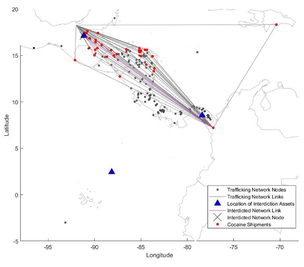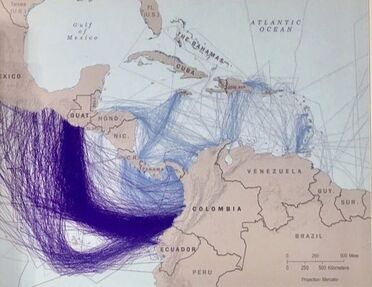Anticipatory InterDiction In Narco-Trafficking Networks

After more than 40 years of U.S.-led counternarcotic efforts in the Western Hemisphere, movements of cocaine by narco-trafficking networks toward the U.S. continue to rise, including an unprecedented 2,976 metric tons in 2016. Cocaine- or ‘narco’-trafficking through the Central American corridor supplies over 80% of the cocaine consumed in North America. Despite numerous related national security concerns , efforts to stem the flow of cocaine into the U.S. have clearly failed . In this project, we investigate spatial adaptive behaviors of narco-trafficking networks in response to various counterdrug interdiction strategies within the cocaine transit zone of Central America and associated maritime areas. Through a collaboration among geography, operations engineering, and criminology researchers, we implement a potentially transformative coupled agent-based and interdiction optimization modeling approach to compellingly demonstrate: (a) how current efforts to disrupt narco-trafficking networks are in fact making them more widespread, resilient, and economically powerful; (b) the potential for alternative interdiction approaches to weaken and contain traffickers.
Research Team
Senior Personnel: Nicholas R. Magliocca (PI, UA), Kevin M. Curtin ( co-I, UA), Diana Dolliver (co-I, UA), and Kendra McSweeney (co-I, The Ohio State University, co-I)
Student Researchers: Ashleigh Price, Konrad Piepke, Kate Pitts
Funding: National Science Foundation EAGER ISN 1837698 (2018-2021)
Publications
Research Team
Senior Personnel: Nicholas R. Magliocca (PI, UA), Kevin M. Curtin ( co-I, UA), Diana Dolliver (co-I, UA), and Kendra McSweeney (co-I, The Ohio State University, co-I)
Student Researchers: Ashleigh Price, Konrad Piepke, Kate Pitts
Funding: National Science Foundation EAGER ISN 1837698 (2018-2021)
Publications
- Magliocca, N.R., McSweeney, K. Sesnie, S.E., Tellman, E., Devine, J.A., Nielsen, E.A., Pearson, Z. Wrathall, D.J., Dávila, A. (2019). Modeling cocaine traffickers and counterdrug interdiction forces as a complex adaptive system. Proceedings of the National Academy of Sciences USA, 116 (16): 7784-7792. DOI: https://doi.org/10.1073/pnas.1812459116
- Tellman, B., Magliocca, N.R., Turner, B.L.,Verburg, P.H. (2020) Illicit-clandestine land transactions - linking pattern to process. Nature Sustainability, 3: 175-181. DOI: https://doi.org/10.1038/s41893-019-0457-1.
- Dávila, A., McSweeney, K., Magliocca, N.R., Rueda, X. (2021). Spatializing illicit global commodity chains. Area. DOI: 10.1111/area.12724. Available at: https://onlinelibrary.wiley.com/share/author/GQEQIWF3Y3EMB2ACTGTV?target=10.1111/area.12724
Illicit Drug Trafficking Networks: Behavioral Responses to InterDiction

Although there is agreement that current interdiction strategies need to change, there is a long history of policy deadlock on how to affect this change. This is, in part, because the processes that link observed narco-trafficking proliferation and innovations in smuggling techniques to specific interdiction strategies are poorly understood. This project will show that a new paradigm is needed in which spatial patterns of narco-trafficking and its proliferation over time are recognized to be—and explicitly modeled as— the result of co-evolution with interdiction operations. This project systematically identifies (1) narco-traffickers’ tendencies for relocating existing or creating new smuggling routes and/or shifting cocaine shipment conveyance methods in response to counterdrug interdiction operations; (2) how those tendencies vary with a range of alternative interdiction strategies; and (3) metrics that move beyond cocaine seizure volumes to better characterize the impacts of counterdrug interdiction of cocaine trafficking network function. This project is developing a scenario testing environment that tightly integrates a Geographic Information Systems (GIS) front end with a modeling and data analytics backend. The testing environment will enable the quantification of narco-traffickers’ spatial and operational adaptive responses across the spectrum of interdiction scenarios, from which predictive ‘behavioral profiles’ will be derived, catalyzing a shift from reactive to anticipatory medium-to long-term counterdrug interdiction strategies.
Research Team
Senior Personnel: Kevin M Curtin (UA, PI), Nicholas R. Magliocca (UA, co-I), Diana Dolliver (UA, co-I), Matthew Hudnall (UA, co-I)
Student Researchers: Ashleigh Price
Funding: National Science Foundation D-ISN 2039975 (2020-2024)
Publications
Research Team
Senior Personnel: Kevin M Curtin (UA, PI), Nicholas R. Magliocca (UA, co-I), Diana Dolliver (UA, co-I), Matthew Hudnall (UA, co-I)
Student Researchers: Ashleigh Price
Funding: National Science Foundation D-ISN 2039975 (2020-2024)
Publications
- Magliocca, N. R. (2023). Intersecting security, equity, and sustainability for transformation in the Anthropocene. Anthropocene, 100396. DOI: https://doi.org/10.1016/j.ancene.2023.100396.
- Magliocca, N.R., Price, A.N.*, Mitchell, P.*, Curtin, K.M., Hudnall, M., McSweeney, K. (2022). Coupling agent-based simulation and spatial optimization models to understand spatially complex and co-evolutionary behavior of cocaine trafficking networks and counterdrug interdiction. IISE Transactions. DOI: https://doi.org/10.1080/24725854.2022.2123998.
- Magliocca, N.R., Dolliver, D.S., Curtin, K.M., McSweeney, K., Price, A.N. (2022). Shifting landscape suitability for cocaine trafficking through Central America in response to counterdrug interdiction. Landscape & Urban Planning, 221: 104359. DOI: https://doi.org/10.1016/j.landurbplan.2022.104359.
- Price, A., Curtin, K. M., Magliocca, N. R., Mitchell, P., Turner, D., McSweeney, K., Dolliver, D. S. (2022). A Family of Models in Support of Realistic Drug Interdiction Location Decision Making. Transactions in GIS. DOI: 10.1111/tgis.12921.
- Magliocca, N.R., Torres, A., Margulies, J.D., Carter, N.H., Gore, M., Arroyo-Quiroz, I., Curtin, K.M., Easter*, T.S., Hübschle, A., Massé, F., McSweeney, K., Rege, A., Tellman, E. (2021). Comparative Analysis of Illicit Supply Network Structure and Operations: Cocaine, Wildlife, and Sand. Journal of Illicit Economies and Development, 3(1): pp. 50–73. DOI: https://doi.org/10.31389/jied.76.
- Tellman, B., Magliocca, N.R., Turner, B.L.,Verburg, P.H. (2020). Understanding the role of illicit transactions in land-change dynamics. Nature Sustainability, 3: 175-181. DOI: https://doi.org/10.1038/s41893-019-0457-1.
- Magliocca, N.R., McSweeney, K. Sesnie, S.E., Tellman, E., Devine, J.A., Nielsen, E.A., Pearson, Z. Wrathall, D.J., Dávila, A. (2019). Modeling cocaine traffickers and counterdrug interdiction forces as a complex adaptive system. Proceedings of the National Academy of Sciences USA, 116 (16): 7784-7792. DOI: https://doi.org/10.1073/pnas.1812459116
- "Towards more spatially disaggregated cocaine supply chain modeling," Magliocca, N. R., Aksu, R., McSweeney, K., Tanveer, H., Curtin, K. M., Keskin, B., Conference of Latin American Geography 2023, Conference of Latin American Geography, Tucson, AZ. (January 2023).
- "Coupling agent-based simulation and spatial optimization models to understand spatially complex and co-evolutionary behavior of cocaine trafficking networks and counterdrug interdiction." Magliocca, N. R., Price, A, Mitchell, P., Curtin, K., Hudnall, M., McSweeney, K., Narco-Landscapes Research Workshop, NASA, Columbus, OH, United States. (July 26,2022).
- "Cocaine Supply Chain Modeling." Aksu, R., Magliocca, N. R., Keskin, B., Production and Operations Management Society Annual Meeting, Production and Operations Management Society. (April 25, 2022).
- “Comparing Illicit Supply Networks: Cocaine, Wildlife, and Sand”. Side Event at the 64th Commission on Narcotic Drugs: Illicit Economies and the Environment. Organized by the Global Initiative Against Transnational Organized Crime. Vienna, Austria, April 15th, 2021.
- “Narco-Trafficking Caused Land-Use Change”. GIZ and UNODC Expert Meeting on Drugs and the Environment. Vienna, Austria (virtual). September 21, 2021.

